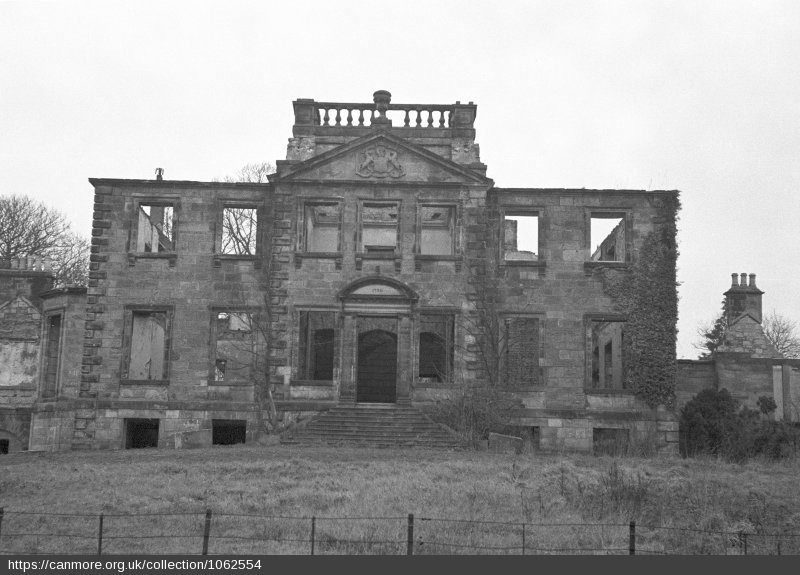The 1st Independent Polish Parachute Brigade
(1 Samodzielna Brygada Spadochronowa)
Stunning Largo House
Now A Ruin - Why?
 © ©RCAHMS
© ©RCAHMS
The Beginning Of The Demise
In early 1946 The 1st Independant Polish Parachute Brigade (1 Samodzielna Brygada Spadochronowa) left Largo House, Upper Largo, Fife. Later that year, The Polish Military Geographical Institute take up residence at Largo House, Fife and stayed until the end of 1946.
The house never "fell into demise" at that point. Yes, the house was empty and no doubt had some battle scars left on it from The 1st Independant Polish Parachute Brigade (1 Samodzielna Brygada Spadochronowa) having been there but there is no reason to believe statements found on the internet that it "fell into demise" at that point.
House Stripping Starts
In 1951 the roof was removed and the house "stripped out", THEN and only THEN did the demise begin. In 1951, as a consequence of being "stripped out" it was declared derelict (and not prior to that as some claim).
To understand why the roof was removed and the house was "stripped out" you have to go back to the history books.
Why Were Grand Houses Stripped Out?
Prior to World War War 1, large country houses were providers of local employment and their future seemed fairly certain.
Pre 19th century, the upper classes lived almost tax free, staff were cheap and plentiful and land around these mansions generated income from farming, forestry and tenants not to say the political power it bought you as well.
In essence, these large country mansions were self sustaining. Stripping out, selling off the effects and demolishing old houses is recorded as happening as early as 1912, it was unusual, although it passed without comment.
However the war changed things and decadent life as we knew it ceased to exist for these former mansion home owners. Add to this the increasing costs of maintaining older properties as they aged further and you start to get the picture, the stripping out and demolitions increased.
Come the end of World War 2, having no further need for them, the government handed back these mansion homes to their former owners. Often these homes were in a state of complete disrepair, damaged from the war and army units taking up residence in them.
Imagine having owned a former mansion home that was in very good condition pre-war only to be handed it back post war in a derelict and dilapidated condition. How heart wrenching for these impoverished mansion owners! And that is exactly what happened all over the UK!
Without funds to repair the property along with property taxes, death taxes (which could be up to 80% of the property value) staff shortages because many had been killed in the war and the old way of life having dis-appeared, suddenly these wealthy families now had large unwanted houses, often seen as milestones around their necks, to deal with.
These houses were no longer self sustaining pads for the wealthy, they were liabilities, devoid of staff or income, willing to take any money that the owner had leftover after the war, which as you can imagine, was very little.
You can see why demolishing "that old mansion" seemed to be a feasible way out of all the expense and headache for them.
House Stripping Gains Momentum
What had started as a small number of mansion demolitions in 1912 now became a raging torrent because by 1955 small palatial houses through to large country houses were getting destroyed at the rate of one every 5 days and still no-one gave it any thought, it seemed a way out of debt and misery.
Another factor that made it very palatable to demolish old houses was that during World War 2 a staggering amount of houses were destroyed in bombing.
Post war, there was an insatiable demand for land to build new houses on so owners of old houses could make a quick profit selling the ground the former mansion had stood on.
This had the effect of creating a temporary feeling in the nation that demolishing old houses was good for the countries future housing needs, so even owners of houses who were having them stripped out (to avoid taxes) would not have felt so bad about destroying the nation's treasures of stately homes.
Please Donate!

Uncover The Past - Support The Future
Each year, about 12,000 people visit this website to trace their Polish ancestry, uncover family stories, and connect with their roots. I believe that history should be accessible to all - but keeping this website alive comes at a cost, 7 years @ £1000 per year with has left a £7000 dent...with only £72 in total donated up to 11/06/25 😱😱😱
Every detail you uncover and every story you piece together helps you piece family history together. Please donate if you found this site useful, help me keep the site alive! Thanks! Jason Nellyer (Researcher & Site Owner)